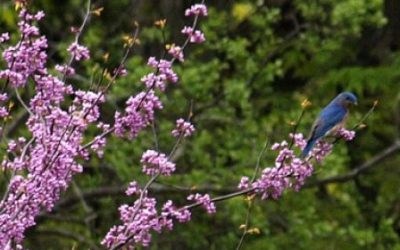Reading Snow Drifts in Your Yard

When we get snow, snow-drifts are the main feature of our winter landscape. Since our prevailing wind comes from the same direction winter and summer, snow-drifts can teach you a lot about the micro-climates found in your yard. Remembering that drifts form in areas of calm, take a look around your yard. The largest drifts will form in the most sheltered spots. You will probably notice that the largest drifts form on the east and southeast sides of your house; the side facing away from the prevailing west and northwest winds. The drifts on the east side of my house can get quite high (7′ during the “Blizzard of ’93) while on the west side, no drifts form at all.
You’ll also be able to observe the windbreak effect of other features in your yard. Some areas may be blown clear by higher wind velocities caused by the channeling effect of landscape features. For instance, the northeast corner of my house gets blown clear of snow because of the increased wind velocity caused by the wind “piling-up” as it tries to round that corner of the house.
Your knowledge of these various exposures to wind within your yard should have an influence on decisions you make during the planting season. You’ll want to take into account the effects of the prevailing wind as you decide on placement of flowerbeds to take advantage of wind drift of fragrance. You will be able to avoid problems caused by planting tender plants (such as rose bushes) in spots that are very windy. Taking wind conditions into account is quite important when considering placement of outdoor living features like decks, cooking areas, swimming pools and fences. There’s no time like now to observe the wind flow through your yard…besides, it’ll give you something to do while you’re out there shoveling your walk.
The main garden feature in winter is the weather. Forecasters always have their hands full trying (and generally failing) to predict the track of storm after storm. Although these storms are dangerous and cause great inconvenience, there are some positive aspects to snowy weather. The term “blanket of snow” is very appropriate. The “blanket’ of snow acts as an insulating barrier much like the fiberglass insulation that you hopefully have in the attic of your home. The layer of snow prevents warmth from the earth from radiating into the atmosphere. This means that the frost level will not penetrate more than a couple of feet deep. This is good news for all our shrubs and trees, especially those that were planted only last season and are not completely established. Another benefit of our “blanket” of snow is the insolative effect it provides for our perennials. In years of “snow drought” the exposed crowns of our beloved perennial flowers are exposed to the cold, drying winds of the depths of winter. The snow will shelter and protect our perennials, lessening the chances of winterkill. If you have beds that the wind has blown bare, consider shoveling snow onto those areas to re-blanket them.







Recent Comments